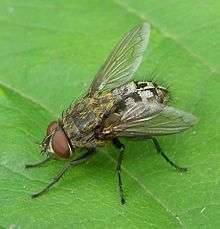Cluster fly
| Cluster flies | |
|---|---|
 | |
| Male Pollenia sp. | |
| Scientific classification | |
| Kingdom: | Animalia |
| Phylum: | Arthropoda |
| Class: | Insecta |
| Order: | Diptera |
| Family: | Calliphoridae |
| Subfamily: | Polleniinae |
| Genus: | Pollenia Robineau-Desvoidy, 1830 |
| Type species | |
| Musca rudis[1] Fabricius, 1794 | |
| Species | |
|
See text | |
The cluster flies or attic flies are the genus Pollenia in the blowfly family Calliphoridae. Unlike more familiar blow flies, such as the bluebottle genus Phormia, they do not present a health hazard because they do not lay eggs in human food. They are strictly parasitic on earthworms; the females lay their eggs near earthworm burrows, and the larvae then infest the worms. However, the flies are a nuisance; when the adults emerge in the late summer or autumn, they enter houses to hibernate, often in large numbers; they are difficult to eradicate because they favour inaccessible spaces such as roof and wall cavities. They are often seen on windows of little-used rooms.
The typical cluster fly Pollenia rudis is about 7 mm long and can be recognised by distinct lines or stripes behind the head, short golden-coloured hairs on the thorax, and irregular light and dark gray areas on the abdomen. Cluster flies are typically slow-moving.
Cluster flies have a widespread distribution. Eight species are found in Britain and 31 in Europe. Pollenia species are also numerous in Australia and New Zealand (over 30 species); they are a common pest in North America. P. rudis has spread widely in association with humans.
Species
- P. amentaria (Scopoli 1763)
- P. angustigena Wainwright 1940
- P. atramentaria (Meigen 1826)
- P. bezziana Rognes 1992
- P. bicolor Robineau-Desvoidy 1830
- P. bulgarica Jacentkovsky 1939
- P. contempta Robineau-Desvoidy 1863
- P. dasypoda Portschinsky 1881
- P. fulvipalpis Macquart 1835
- P. griseotomentosa (Jacentkovsky 1944)
- P. hungarica Rognes 1987
- P. labialis Robineau-Desvoidy 1863
- P. leclercqiana (Lehrer 1978)
- P. luteovillosa Rognes 1987
- P. mayeri Jacentkovsky 1941
- P. mediterranea Grunin 1966
- P. moravica (Jacentkovsky 1941)
- P. paupera Róndani 1862
- P. pectinata Grunin 1966
- P. pediculata Macquart 1834
- P. ponti Rognes 1991
- P. pseudintermedia Rognes 1987
- P. pseudorudis Rognes, 1985
- P. rudis (Fabricius 1794)
- P. ruficrura Róndani 1862
- P. similis (Jacentkovsky 1941)
- P. tenuiforceps Róndani 1928
- P. vagabunda (Meigen 1826)
- P. venturii Zumpt 1956
- P. vera Jacentkovsky 1936
- P. verneri Rognes 1992
- P. viatica Robineau-Desvoidy 1830[2]
References
- ↑ Sabrosky, Curtis W. (1999). "Family-Group Names in Diptera An annotated catalog" (PDF). MYIA, The International Journal of the North American Dipterists' Society. Leidan: Backhuys Publishers. 10. Archived from the original (PDF) on 11 April 2008. Retrieved 31 May 2008.
- ↑ Rognes, Dr Knut; Pape, Dr Thomas (19 April 2007). "Taxon details: Calliphoridae". Fauna Europaea version 1.1,. Retrieved 2008-05-31.
External links
- Images of some cluster fly species: Pollenia amentaria Scopoli ; Pollenia angustigena Wainwright and Pollenia rudisFabricius.
- European including Russia species